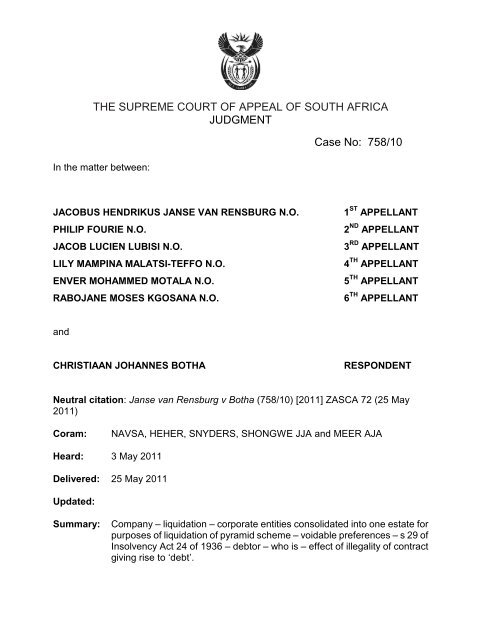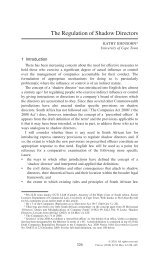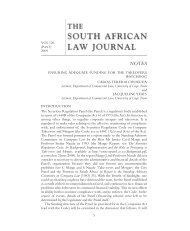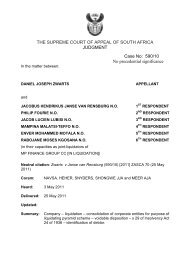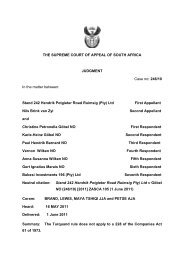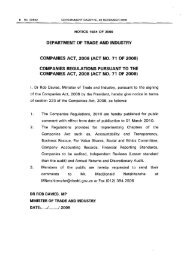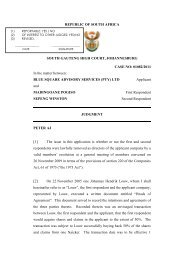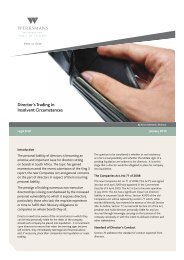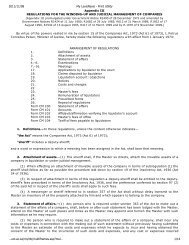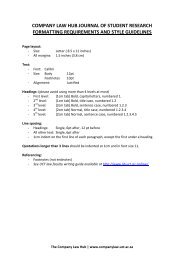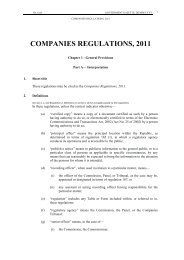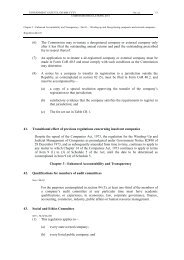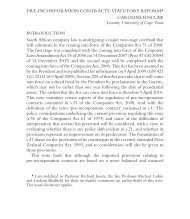ZASCA 72 (25 May 2011) - Company Law Hub
ZASCA 72 (25 May 2011) - Company Law Hub
ZASCA 72 (25 May 2011) - Company Law Hub
You also want an ePaper? Increase the reach of your titles
YUMPU automatically turns print PDFs into web optimized ePapers that Google loves.
THE SUPREME COURT OF APPEAL OF SOUTH AFRICA<br />
JUDGMENT<br />
In the matter between:<br />
Case No: 758/10<br />
JACOBUS HENDRIKUS JANSE VAN RENSBURG N.O.<br />
PHILIP FOURIE N.O.<br />
JACOB LUCIEN LUBISI N.O.<br />
LILY MAMPINA MALATSI-TEFFO N.O.<br />
ENVER MOHAMMED MOTALA N.O.<br />
RABOJANE MOSES KGOSANA N.O.<br />
1 ST APPELLANT<br />
2 ND APPELLANT<br />
3 RD APPELLANT<br />
4 TH APPELLANT<br />
5 TH APPELLANT<br />
6 TH APPELLANT<br />
and<br />
CHRISTIAAN JOHANNES BOTHA<br />
RESPONDENT<br />
Neutral citation: Janse van Rensburg v Botha (758/10) [<strong>2011</strong>] <strong>ZASCA</strong> <strong>72</strong> (<strong>25</strong> <strong>May</strong><br />
<strong>2011</strong>)<br />
Coram:<br />
NAVSA, HEHER, SNYDERS, SHONGWE JJA and MEER AJA<br />
Heard: 3 <strong>May</strong> <strong>2011</strong><br />
Delivered: <strong>25</strong> <strong>May</strong> <strong>2011</strong><br />
Updated:<br />
Summary:<br />
<strong>Company</strong> – liquidation – corporate entities consolid ated into one estate for<br />
purposes of liquidation of pyramid scheme – voidabl e preferences – s 29 of<br />
Insolvency Act 24 of 1936 – debtor – who is – effec t of illegality of contract<br />
giving rise to ‘debt’.
2<br />
____________________________________________________________________________________<br />
ORDER<br />
On appeal from: North Gauteng High Court (Pretoria) (Fabricius AJ sitting as court of<br />
first instance):<br />
1. The appeal is upheld with costs.<br />
2. The order of the court a quo is set aside and re placed by the following:<br />
‘1. The payments amounting to R192 710.00 made to t he defendant are set aside in<br />
terms of s 29 of the Insolvency Act 24 of 1936.<br />
2. The defendant is ordered in terms of s 32(3) of the Act to pay the amount of<br />
R192 710.00 to the plaintiffs together with interes t thereon at the prescribed rate from date<br />
of judgment to date of payment.<br />
3. The defendant is ordered to pay the costs of sui t.’<br />
_______________________________________________________________________<br />
JUDGMENT<br />
_____________________________________________________________________<br />
HEHER JA (NAVSA, SNYDERS, SHONGWE JJA AND MEER AJA concurring):<br />
[1] This is an appeal against a judgment of Fabrici us AJ in the North Gauteng High<br />
Court, Pretoria with leave of the learned judge.<br />
[2] The appellants, the joint liquidators of MP Fi nance Group CC, who are engaged in<br />
winding-up the consolidated estate commonly referre d to as the Krion pyramid scheme,<br />
instituted action under s 29 of the Insolvency Act 24 of 1936 against the respondent, Mr<br />
Botha, as an alleged investor in the scheme. They c laimed that within six months of the<br />
liquidation of the scheme on 5 April 2002 it had pa id amounts totalling R192 710.00 to the<br />
respondent at a time when its liabilities exceeded its assets and that the effect of those<br />
payments was to prefer him above the general body o f the scheme’s creditors. They<br />
sought orders setting aside the disposition and for payment of the amounts thus disposed<br />
of.<br />
[3] The action was defended. The respondent set up various defences. In so far as
they remain relevant they were the following:<br />
1. He was not a party to the orders made by Hartzen berg J concerning the<br />
consolidation of the various entities involved in t he perpetration of the scheme and which<br />
purported to confer authority on the liquidators to administer the estates of those as one<br />
close corporation, and, consequently was not bound by the terms of those orders.<br />
2. He denied that the Krion scheme carried on any b usiness at all or received any<br />
payments from or made dispositions to him.<br />
3. He placed in dispute that MP Finance Consultants CC, one of the entities being<br />
administered by the liquidators as part of the cons olidated estate, had been involved in the<br />
Krion scheme.<br />
4. He pleaded that Ms Marietjie Prinsloo had utilis ed the corporate entities (other than<br />
MP Finance Consultants CC) being administered by th e liquidators as well as various<br />
unincorporated entities or trading names as a smoke screen for her personal involvement<br />
in and control of the pyramid scheme, and that, to the extent that he had invested in the<br />
scheme, he was investing with Ms Prinsloo in her pe rsonal capacity.<br />
5. He denied that the payments made to him had the effect of preferring him above<br />
other creditors in the estate.<br />
6. Because the scheme was unlawful and all obligati ons incurred or undertaken were<br />
void, the scheme could not be a debtor for the purp oses of s 29 and he, as an investor,<br />
could not be its creditor.<br />
3<br />
[4] The action proceeded to trial. The liquidators relied upon the expert evidence of Mr<br />
Harcourt-Cooke, an auditor who had examined, recons tructed and analysed the affairs of<br />
the corporate entities in so far as they could be d one in the absence of books of account<br />
or bank statements. The first appellant also gave e vidence. He had been the deponent in<br />
support of the application proceedings before Hartz enberg J in 2003 and his affidavit in<br />
that matter was made available to the trial judge. The defendant testified in his own<br />
defence and called two former employees of Ms Prins loo viz Ms Elaine Denysschen and<br />
Ms Jessie Denysschen to speak to the relationship b etween Ms Prinsloo and her<br />
businesses. In addition Mr George Ewan, the agent w ho introduced Mr Botha as an<br />
investor and received his payments testified about the role of Ms Prinsloo in operating the<br />
investment business.
4<br />
[5] Fabricius AJ held that:<br />
1. a court is not competent to ‘create’ either a co mpany or a close corporation or any<br />
other statutory entity unless this is done strictly in accordance with the applicable statute,<br />
finding, in effect, that Hartzenberg J had acted be yond his powers in consolidating the<br />
various entities of the scheme into one for the pur poses of liquidation and ordering that the<br />
consolidated estate be wound up as a (non-existent) close corporation;<br />
2. the so-called ‘consolidation order’ could not an d did not bind the defendant;<br />
3. the liquidators had not proved the jurisdictiona l elements required by s 29 of the<br />
Act, by which it appears that the learned judge mea nt that they had not established the<br />
debtor and creditor relationship inherent in the ri ght to claim under the section.<br />
[6] The learned judge accordingly held that he had no choice but to dismiss the<br />
liquidators’ claim.<br />
[7] In the Steyn judgment delivered simultaneously with this judgmen t I have explained<br />
the terms, background, and meaning of the orders ma de by Hartzenberg J. If a defendant<br />
in proceedings brought by the liquidators in the co urse of winding-up the Krion scheme is<br />
proved to be an investor in the scheme, the orders made by Hartzenberg J will be<br />
regarded as res judicata between him or her and the liquidators, save to the extent that<br />
the investor brings himself or herself within the e xception described by Conradie AJA in<br />
Fourie’s case. The rule assumes that a final binding judgmen t is a correct judgment<br />
whether that be so or not. That applies with equal force to Mr Botha.<br />
[8] In the Steyn appeal I have also held that, in accordance with th e orders in their<br />
context the scheme was a debtor as contemplated in s 29 in respect of any dispositions<br />
that it made to investors by repayment of capital o r interest arising from the operation of<br />
the scheme. That position holds with regard to the action instituted by the liquidators in<br />
this matter.<br />
[9] Counsel’s argument based on the illegality of t he scheme, while superficially<br />
attractive, does not withstand closer analysis. In Commissioner for Inland Revenue v
5<br />
Insolvent Estate Botha t/a ‘Trio Kulture’ 1990 (2) SA 548 (A) this very problem arose in the<br />
context of an appeal against a tax assessment issue d by the Commissioner on income<br />
from ‘occasional sales’. The respondent contended t hat the insolvent had been conducting<br />
an illegal lottery, the effect of which was to null ify the effect of all ‘sales’ which were<br />
undertaken in the course of the lottery. Hoexter JA assumed that the Trio scheme<br />
constituted such a lottery and went on (at 556A-557 B) to explain why the sales were<br />
nevertheless not deprived of statutory efficacy:<br />
‘Since a contract which is forbidden by statute is illegal and void, a Court is bound to take<br />
cognisance of such illegality; and it cannot be ask ed to enforce or to uphold or to ratify such a<br />
contract: Cape Dairy and General Livestock Auctioneers v Sim 1924 AD 167 at 170. It is<br />
sometimes said that any juristic act performed in d efiance of a statutory prohibition is not only<br />
ineffective, but further that it should notionally be thought away. Thus in Schierhout v Minister of<br />
Justice 1926 AD 99, Innes CJ, having cited the Code 1.14.5, remarked at 109:<br />
“So that what is done contrary to the prohibitio n of the law is not only of no effect, but must be<br />
regarded as never having been done - and that wheth er the lawgiver has expressly so decreed or<br />
not; the mere prohibition operates to nullify the a ct.”<br />
Such general propositions are useful to stress the concept that inter partes an illegal jural act is<br />
devoid of legal consequence. But from such convenie nt generalisations it is not to be inferred that<br />
because an agreement is illegal a Court will in all circumstances and for all purposes turn a blind<br />
eye to its conclusion; or deny its very existence. As pointed out by Van den Heever J in Van der<br />
Westhuizen v Engelbrecht and Spouse; Engelbrecht v Engelbrecht 1942 OPD 191 at 199:<br />
“When we say a juristic act is void or voidable , we pass judgment upon it from various points of<br />
view, basing our judgment upon the degree or direct ion of its effectiveness....”<br />
And at 200:<br />
“... (J)uristic acts may be impugned from varyi ng directions and to different degrees.”<br />
That the above approach is jurisprudentially sound is demonstrated by many everyday practical<br />
situations. Obvious examples which spring to mind a re sales conducted on a Sunday in violation of<br />
provincial ordinances, and agreements pertaining to unlawful dealing in rough or uncut diamonds or<br />
unwrought precious metals. To the conclusion of suc h illegal agreements the law accords<br />
recognition for particular purposes. That they are void inter partes does not rob them of all legal<br />
result. For example, in dealing with a contraventio n of s 142 of Transvaal <strong>Law</strong> 15 of 1898, Innes CJ<br />
in R v Goldflam 1904 TS 794 remarked at 796:<br />
“The detectives proved, and Mr Stallard does not controvert the point, that there was an ag reement<br />
to buy; and that if the transaction had not been fo rbidden by s 141 it would have been an
6<br />
agreement upon which an action could have been brou ght. If that be so, it appears to me that H<br />
there was a purchase within the meaning of the sect ion.”<br />
Cases in point are not confined to the criminal law . In Van der Westerhuizen v Engelbrecht ( supra )<br />
Van den Heever J elucidated the logical distinction with which he was there concerned by reference<br />
to the facts of Wilken v Kohler 1913 AD 135, in which case this Court held that in terms of s 49 of<br />
Ord 12 of 1906 of the Orange River Colony an oral c ontract for the sale of land in the Free State<br />
was void. Having mentioned (at 201) that a party to such an agreement was ( qua contracting party)<br />
remediless, Van den Heever J proceeded to say:<br />
“In other directions the contract did have lega l effect. It would have been futile for either part y to<br />
claim, as against the tax collector, that no sale h ad taken place or against creditors (supposing that<br />
had been the object of the transaction) that no dis position in fraud of creditors had been<br />
committed.”<br />
Assuming that the 'kweekkontrakte' are hit by the p rohibition in the Gambling Act, the fact of the<br />
matter is that in the instant case the Court is not being asked to 'enforce' or to 'uphold' or to 'rat ify' a<br />
contract which the law expressly forbids. The Court merely looks at the provisions of the Act in<br />
order to see whether the agreement contained in the 'kweekkontrak' comes within the literal<br />
language of the Act.’<br />
[10] Thus the fact that the scheme was illegal thro ugh and through as a pyramid<br />
scheme and a contravention of various statutes, doe s not necessarily deprive the<br />
liquidators of the insolvent scheme of the debtor s tatus contemplated by s 29. The plain<br />
wording of that section does not compel such a conc lusion. That section is designed to<br />
facilitate the administration of an insolvent estat e, and, particularly, the recovery of assets<br />
disposed of by the insolvent under the circumstance s provided for in the section, for the<br />
benefit of creditors of the estate. The section, be ing remedial, should be interpreted to<br />
assist the process, not to hinder it. If an insolve nt stands in relation to the person to whom<br />
he disposes of property as one who owes a debt, why should the illegality of the<br />
insolvent’s business be permitted to influence the power and duty of a liquidator to rely on<br />
s 29 to recover the money or asset disposed of? To allow it to do so would defeat the<br />
purpose of the provision, and, as this liquidation process demonstrates, work great<br />
inequity on the general body of creditors while fav ouring individuals who have no claim to<br />
favour. It seems to me, in the circumstances of thi s case, to be essential to a proper<br />
winding-up that the underlying illegality of the na ture in question should be disregarded<br />
when interpreting s 29. To do so will not conduce t o the upholding of an illegal contract.
7<br />
[11] Before I turn to a consideration of the defenc e evidence certain observations arising<br />
from the evidence of Mr Janse van Rensburg are pert inent. In the first instance, Ms<br />
Prinsloo created and operated a pyramid scheme whic h procured investments from<br />
gullible or greedy members of the public. There was only one scheme. Its business<br />
commenced with the diversion of funds from the micr o-lending business of MP Finance<br />
Consultants CC. Thereafter, in an effort to confer legitimacy on the business Ms Prinsloo<br />
successfully made use of registered corporate entit ies (the entities in the consolidated<br />
estate). As the consolidation orders emphasised, th e pyramid scheme was one ongoing<br />
enterprise from beginning to end. Assets and liabil ities were moved from one to the next<br />
without formality or any trappings of ownership. Ca sh collected from investors under one<br />
name was used to pay investments to other investors in another name (albeit not the<br />
name of the entity with which he or she had contrac ted or ‘invested’).<br />
[12] The application was brought to deal with the w hole scheme. The liquidators had no<br />
interest in winding up parts of it. They readily co nceded that they could not distinguish<br />
between the input and output of the various entitie s. Neither did they have knowledge of<br />
why Ms Prinsloo had used the names of unincorporate d entities (save for M & B Cooperative<br />
Partnership which seems to have anticipat ed the registration of a co-operative).<br />
[13] The liquidators applied to liquidate the regis tered corporate entities – nobody<br />
suggests that any such entity that participated in the scheme was omitted. They<br />
recognised that Ms Prinsloo had used trading names to further the scheme. Such names<br />
were in themselves of little significance since the y did not acquire or dispose of investors’<br />
money for themselves; they were either the alter eg o of Ms Prinsloo or the names under<br />
which it suited her to operate the corporate entiti es. Some were mentioned by the<br />
liquidators in the application for condonation; oth ers (Finsure and MP Finance Sacco, for<br />
instance) were not. Even Ms Prinsloo had admitted a t the s 417 enquiry that she could not<br />
disentangle the roles of the various participants. In this context the orders made by<br />
Hartzenberg J were directed to a single main object : by consolidating all the apparent<br />
operating arms of the scheme into one coherent clos e corporation the liquidators were to<br />
be relieved of the necessity of attribution, especi ally in relation to the recovery of assets.
8<br />
That is what the order achieved. Before the making of the order the learned judge may or<br />
may not have considered whether the role of Ms Prin sloo warranted the inclusion of her<br />
(or her estate, since she may by then have been seq uestrated) in the consolidation. That<br />
did not happen and the effect of the order was to d efine the scheme according to the<br />
scope of the business conducted under the umbrella of the corporate entities.<br />
[14] This last conclusion does not mean that a defe ndant in Mr Botha’s position cannot,<br />
by satisfactory evidence, persuade a court that he contracted with a party or entity outside<br />
the ambit of the scheme. In such a case the liquida tors will have failed to discharge the<br />
onus on them. As I have noted his counsel contended that Mr Botha invested with Ms<br />
Prinsloo personally. In order to evaluate this subm ission it is necessary to analyse the<br />
evidence in some depth.<br />
[15] Neither Mr Harcourt-Cooke nor the first appell ant possessed personal knowledge of<br />
the relationships established between individual in vestors and the scheme or Ms Prinsloo.<br />
Both expressed opinions based upon in-depth study o f the affairs of the pyramid scheme<br />
as reflected in the investor files, property and bo nd searches, the creditors claims and the<br />
evidence of Ms Prinsloo and others in other proceed ings. Nevertheless the evidence of<br />
Van Rensburg that all her trading activities were d efinitely part of the same scheme should<br />
not be disregarded. No-one regarded the difference in names as important. They were all<br />
an attempt by Prinsloo to legitimise her activities . However it is also clear from all the<br />
evidence that ‘everybody regarded the investments a s made with Ms Prinsloo’.<br />
[16] That the corporate entities (other than Krion Financial Services Ltd towards the end<br />
of the life of the scheme) were empty shells in the sense of the absence of proof of assets<br />
or liabilities, bank accounts, financial records an d minute books is also clear. However<br />
those facts do not go very far to establishing the identity of the operator or owner of the<br />
investment scheme because of its entirely cash-base d business strategy and the total lack<br />
of concern showed by Ms Prinsloo and her associates towards distinguishing between the<br />
corporate entities. It must also be noted that alth ough there was evidence of a regular<br />
division of investors cash received between agents (10%) and Ms Prinsloo and her family<br />
members, this is consistent with her general disreg ard for legal distinctions. She
9<br />
apparently neither contracted in her own name nor u sed documents which suggested that<br />
she intended such an impression to be created in th e minds of investors.<br />
[17] Mr Ewan, as a witness, was ambivalent. He does not seem to have been much<br />
aware of legal distinctions. Early in his evidence he said,<br />
‘Die dokumentasie het kort-kort verander, maar niks het verander nie . . . daar was nie ‘n<br />
maatskappy nie, ons het vir Marietjie gewerk . . . jy het jou geld by Marietjie belê. . . [Sy] was die<br />
lewe en vlees en bloed van die maatskappye.’ (My emphasis.)<br />
Later he admitted that, as instructed, he had repre sented to investors that they were<br />
dealing with a ‘kapitaal-kragtige’ company.<br />
[18] Mr Botha was first approached by Ewan to inves t in the cash loan business (of MP<br />
Financial Consultant CC). It was represented to him that it was a company for investment<br />
and a registered business, and that convinced him t o invest in it. The only knowledge he<br />
had of Ms Prinsloo’s businesses and organisation wa s derived from what Ewan told him.<br />
[19] Ms Jessie Denysschen who was an employee invol ved in the administration<br />
testified:<br />
‘MP Finance het begin met hierdie beleggings en ons het by die cash loans begin te werk, en toe<br />
het sy [Ms Prinsloo] oorgegaan na ander maatskappye , na die beleggings afdeling.’ (My emphasis)<br />
[20] Perhaps more valuable than the recollections o f naïve and unskilled witnesses<br />
uttered many years after the event are the inferenc es provided by contemporaneous<br />
documents. The investor file of Mr Botha was produc ed at the trial. As the testimony<br />
establish such files were ‘meticulously’ maintained by the persons administering the<br />
scheme. In the file were the following relevant doc uments:<br />
1. On 8 August 2001 Mr Botha signed what purported to be a subscription for shares<br />
in Martburg Finansiële Dienste Bpk at R5000 per uni t (paying R20 000);<br />
2. On 15 August 2001 Botha and Ewan signed an ‘ontv angserkenning’ (receipt)<br />
recording that Ewan, as agent for Martburg Finansië le Dienste Bpk had received R70 000<br />
from Botha ‘for shares purchased’ in that company;<br />
3. (a) On 16 August 2001 Botha, as ‘shareholder’, s igned a ‘membership<br />
certificate’ in ‘MP Finance Sacco’ for a payment of R70 000 for 12 months at a return of 10
10<br />
per cent per month. This document was apparently co untersigned by Ms Prinsloo (Pelser)<br />
under circumstances not explained in evidence.<br />
(b)<br />
On the same day Botha, as ‘shareholder’, signed a ‘share agreement’ with MP<br />
Finance Sacco represented by Prinsloo (who counters igned) in which receipt of R70 000<br />
was acknowledged and which provided for payment of returns at a rate of R7000 per<br />
month.<br />
4. On 17 August 2001 Botha and Ewan signed a receip t recording that Ewan had<br />
received R170 000 for shares purchased in the same company.<br />
5. On 6 September 2001 Botha purported to subscribe for shares in Martburt<br />
Finansiële Dienste Bpk to an amount of R20 000.<br />
6. (a) On 14 October 2001 Botha was ostensibly issu ed with a ‘membership<br />
certificate’ in M & B Korporasie Bpk for an investm ent of R62 768,57 for 12 months at a<br />
return of 10 per cent per month. The certificate wa s signed by Botha and H H Prinsloo (the<br />
husband of Ms Prinsloo).<br />
(b)<br />
On the same day Botha was issued with a ‘member ship certificate’ in M & B<br />
Korporasie Bpk for an investment of R20 000 for 12 months at a return of 10 per cent per<br />
month. This too bears the signatures of Botha and H H Prinsloo.<br />
7. On 22 October 2001 Botha was issued with a ‘memb ership certificate’ in M & B Koöperasie<br />
Bpk (sic) in return for an investment of R 20 000 paying ‘dividends’ of R2000 per<br />
month and bearing his own signature and that of H H Prinsloo.<br />
8. (a) On 18 January 2002 Botha was issued with a ‘ membership certificate’ signed<br />
by H H Prinsloo on behalf of M & B Ko-öperasie Bpk in relation to an investment of R170<br />
000 for four months at a return of 10 per cent per month.<br />
9. On <strong>25</strong> January 2002 Botha was once again the reci pient of a ‘membership<br />
certificate’ in M & B Ko-öperasie Bpk for an invest ment of R170 000 bearing a return of<br />
R17 000 per month. This document appears to have be en signed by Botha, Ewan and H<br />
H Prinsloo.<br />
(b)<br />
On the same day Botha was issued with a ‘certif icate of membership’ in the same<br />
entity reflecting an amount of R20 000 invested for three months at a 10 per cent return<br />
each month.<br />
10. On a date not identified Botha purported to app ly for membership in M & B Koöperasie<br />
Bpk, stating that he had had insight into the objectives and operations of that
entity ‘as set out in the information document and<br />
11<br />
its statutes’. The truth of this<br />
acknowledgment was not investigated in evidence bea ring in mind that Ms Prinsloo<br />
apparently intended to register the co-operative bu t her application to do so was<br />
apparently refused.<br />
[21] Certain of these documents probably represente d reinvestments of earlier matured<br />
investments.<br />
[22] A consistent element in the administration of the scheme was an accounting to<br />
investors on documentation headed ‘MP Financial Ser vices’ but which contained no<br />
reference to the entity in which the investment had been made or the identity of the payer<br />
of interest or ‘dividends’. It may be assumed as a probable inference that MP Financial<br />
Services was merely a vehicle for administration pu rposes. The use of the name favours<br />
the case of neither party.<br />
[23] With the exception of MP Finance Sacco, the re cipients of Mr Botha’s investments<br />
were entities expressly consolidated into MP Financ e Group CC and administered by the<br />
appellants as such in terms of the orders of Hartze nberg J.<br />
[24] Counsel for Mr Botha submitted that MP Finance Sacco was, on the probabilities, a<br />
vehicle used by Ms Prinsloo to pursue her own perso nal business agenda. I think the<br />
submission is far-fetched. As I have pointed out th e orders of Hartzenberg J by which Mr<br />
Botha is bound were premised on the acceptance that Ms Prinsloo carried on one<br />
seamless scheme under the auspices of the corporate entities. Given the terms, nature,<br />
timing and circumstances of Mr Botha’s involvement in MP Finance Sacco it is<br />
inconceivable that it was operated outside of the o verall scheme.<br />
[<strong>25</strong>] The probabilities disclosed by the evidence ar e that Ms Prinsloo intended to<br />
operate the whole swindle under the umbrella of the companies albeit subject to her<br />
direction and control. The cash brought into the sc heme (sometimes apparently as much<br />
as R20 million in a day) belonged to the principal represented by the agent who dealt with<br />
the investors on each occasion and which was one of the entities included in the
12<br />
consolidated estate, albeit that because such trans actions were void and unlawful each<br />
investor obtained an immediate right to reclaim his investment. (In fact no-one appears to<br />
have exercised that right, being more interested in the returns.)<br />
[26] The payment made to Mr Botha was made by one o f the entities in the consolidated<br />
estate of the scheme and were dispositions from tha t estate. That the liquidators were<br />
unable to prove which entity paid the money is of n o relevance in the light of the orders,<br />
since the scheme was a debtor contemplated in s 29. Mr Botha and the scheme occupied<br />
a relationship of creditor and debtor for the purpo ses of that section.<br />
[27] When the payments were made the liabilities of the consolidated estate exceeded<br />
the value of its assets. That was established by th e order and repeated in evidence by Mr<br />
Harcourt-Cooke.<br />
[28] Mr Botha was an investor in the scheme, which was the subject of the rule nisi<br />
published according to the instructions of the High court. However he adduced no<br />
evidence which might have had the effect of releasi ng him from the binding effect of the<br />
orders made when the rules were confirmed.<br />
[29] It follows that the appeal must succeed. The f ollowing order is made:<br />
1. The appeal is upheld with costs.<br />
2. The order of the court a quo is set aside and re placed by the following:<br />
‘1. The payments amounting to R192 710.00 made to t he defendant are set aside in<br />
terms of s 29 of the Insolvency Act 24 of 1936.<br />
2. The defendant is ordered in terms of s 32(3) of the Act to pay the amount of<br />
R192 710.00 to the plaintiffs together with interes t thereon at the prescribed rate from date<br />
of judgment to date of payment.<br />
3. The defendant is ordered to pay the costs of sui t.’<br />
APPEARANCES<br />
____________________<br />
J A Heher<br />
Judge of Appeal
APPELLANTS:<br />
F du Toit SC<br />
Strydom & Bredenkamp Inc, Pretoria<br />
Symington & de Kok, Bloemfontein<br />
13<br />
RESPONDENT:<br />
T Strydom<br />
Mills & Groenewald Attorneys,<br />
c/o Van Zyl Le Roux & Hurter Inc, Pretoria<br />
Naudes Attorneys, Bloemfontein


